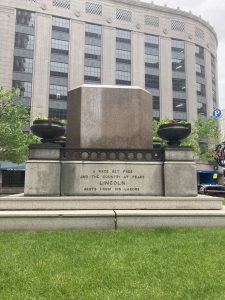Monuments and History
Last year, following an intense online campaign by Boston-area activist Troy Bullock, the Emancipation Memorial was taken down from Boston’s Park Square, a block away from Boston Common. The Emancipation Memorial was a replica of the the Freedman’s Memorial erected in Washington DC in the wake of Lincoln’s assassination. The DC monument was paid for largely by donations by newly freed African-Americans, though the fundraising campaign was run by a white philanthropic organization and the sculpture was designed by a Massachusetts-born artist.
Troy’s case for removing the monument turns on its iconography: at a glance, the artwork places Lincoln in the role of the beneficent White savior, with the Black man apparently kneeling at his feet (video link). Yet those who look more closely (link1 | link2) see a different message: a freed man rising from a state of bondage, his fetters broken. On the other hand, as BU graduate Raul Fernandez points out in a BU Today opinion piece, the monument was erected at the direction of a White philanthropic organization, though it was funded by Black donations, and Frederick Douglass raised objections to its design. For a further twist, check out this interview of a descendant of the freed slave who modeled for the sculpture: link (the key part runs from 5:00-12:00).Read and watch the linked sources, then post a response addressing one or more of the following questions, or give a response all your own:
- Was Boston’s mayor right to take down the Emancipation Memorial?
- Who decides what a monument means? Historians or ordinary passers-by?
- What’s more important in weighing the meaning of the Freedman’s Monument? The artist’s intent? The model’s intent? The funders’ intent? The organizers’ intent? Or maybe the past doesn’t matter—only the impressions of people today matter?

